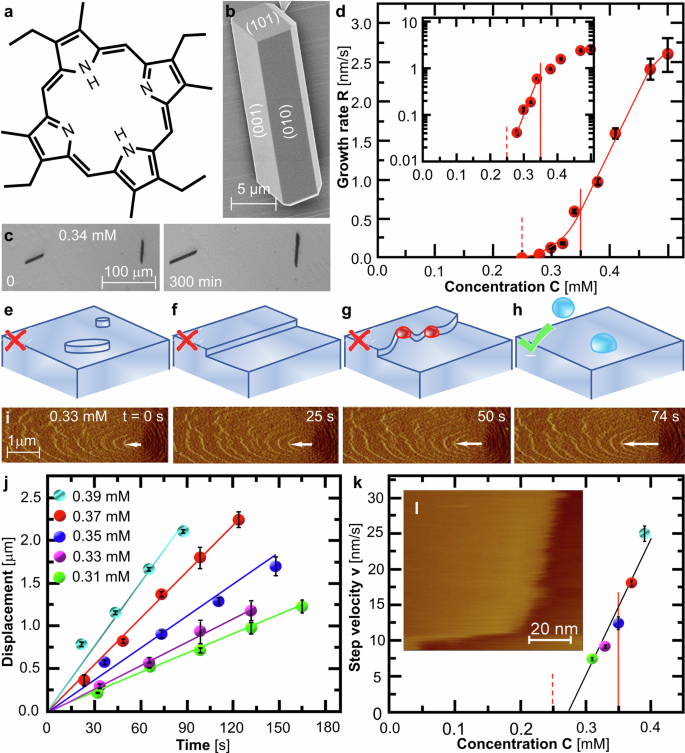有机晶体特有的双重生长模式依赖于介观液体前驱体。
IF 5.9
2区 化学
Q1 CHEMISTRY, MULTIDISCIPLINARY
引用次数: 0
摘要
有机溶剂是合成用于制药和光学设备等用途的高价值晶体的主要载体。在用较弱的范德华力取代水环境中占主导地位的氢键和极性吸引力如何影响晶体生长机制(包括其决定性特征,即晶体是经典生长还是非经典生长)方面,仍然存在知识空白。在这里,我们展示了依托卟啉 I 晶体罕见的双重生长模式,即液态前驱体与晶体表面结合生成层叠,然后通过结合溶质分子横向生长。我们的研究结果表明,前驱体是介观的富溶质团簇,这是一种受有机溶质之间的弱键等因素影响的独特阶段。前驱体引发的层状堆叠的横向扩散主要依赖于直接从溶液中提供的大量溶质,绕过了沿晶体表面的扩散;这种直接结合途径可能也是有机溶剂所独有的。演变为非晶粒子的晶簇不会无缝地融入晶格。在高过饱和度条件下快速生长的晶体,大多是非经典晶体,不会产生过度应变。我们的研究结果表明,有机体系中典型的弱相互作用通过支持液态前驱体和促成多层堆叠的扩散,促进了非经典生长模式。本文章由计算机程序翻译,如有差异,请以英文原文为准。


A dual growth mode unique for organic crystals relies on mesoscopic liquid precursors
Organic solvents host the synthesis of high-value crystals used as pharmaceuticals and optical devices, among other applications. A knowledge gap persists on how replacing the hydrogen bonds and polar attraction that dominate aqueous environments with the weaker van der Waals forces affects the growth mechanism, including its defining feature, whether crystals grow classically or nonclassically. Here we demonstrate a rare dual growth mode of etioporphyrin I crystals, enabled by liquid precursors that associate with crystal surfaces to generate stacks of layers, which then grow laterally by incorporating solute molecules. Our findings reveal the precursors as mesoscopic solute-rich clusters, a unique phase favored by weak bonds such as those between organic solutes. The lateral spreading of the precursor-initiated stacks of layers crucially relies on abundant solute supply directly from the solution, bypassing diffusion along the crystal surface; the direct incorporation pathway may, again, be unique to organic solvents. Clusters that evolve to amorphous particles do not seamlessly integrate into crystal lattices. Crystals growing fast and mostly nonclassically at high supersaturations are not excessively strained. Our findings demonstrate that the weak interactions typical of organic systems promote nonclassical growth modes by supporting liquid precursors and enabling the spreading of multilayer stacks. Organic solvents are used to produce high-value crystals such as pharmaceuticals, organic semiconductors, and optical devices, but our understanding of the fundamental processes of crystal growth from organic solutions is limited. Here, the authors use time-resolved in situ atomic force microscopy to show a nonclassical, dual growth mode of etioporphyrin I crystals from mesoscopic solute-rich clusters.
求助全文
通过发布文献求助,成功后即可免费获取论文全文。
去求助
来源期刊

Communications Chemistry
Chemistry-General Chemistry
CiteScore
7.70
自引率
1.70%
发文量
146
审稿时长
13 weeks
期刊介绍:
Communications Chemistry is an open access journal from Nature Research publishing high-quality research, reviews and commentary in all areas of the chemical sciences. Research papers published by the journal represent significant advances bringing new chemical insight to a specialized area of research. We also aim to provide a community forum for issues of importance to all chemists, regardless of sub-discipline.
 求助内容:
求助内容: 应助结果提醒方式:
应助结果提醒方式:


